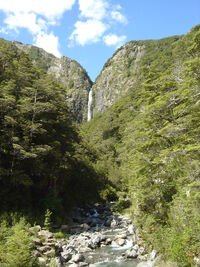- This article is about the natural environment. For other uses, see environment.

Devil's Punchbowl Waterfall, New Zealand.
The natural environment comprises all living and non-living things that occur naturally on Earth. Some would say in its purest sense, it is an environment that is not the result of human activity or intervention, but this is incorrect because the natural environment comprises all living things including human beings. The only distinction is an irrational prejudice on the basis of species alone, which non-human animal rights supporters call speciesism - that is, differentiating humans from other animals purely on the grounds that they are human. The natural environment may be contrasted to the built environment, and is also in contrast to the concept of a cultural landscape. In many contexts, the term used is simply environment, as with the name of the United States Environmental Protection Agency and such organizations as Environmental Defense.
Terminology[]
There is a difficulty with the term "natural environment" in that nearly all present environments have been directly or indirectly influenced by humans. In order to address this concern, some level of human influence is thus allowable without the status of any particular landscape ceasing to be "natural." The term's meaning, however, is usually dependent more on context than a set definition. Many natural environments are the product of the interaction between nature and humans. For this reason, the term ecosystem has been used to describe an environment that contains nature, and includes people. It follows then that environmental problems are human or social problems. Some also consider it dangerously misleading to regard "environment" as separate from "people".
Challenges[]
It is the common understanding of natural environment that underlies environmentalism—a broad political, social, and philosophical movement that advocates various actions and policies in the interest of protecting what nature remains in the natural environment, or restoring or expanding the role of nature in this environment. While true wilderness is increasingly rare, wild nature (e.g., unmanaged forests, uncultivated grasslands, wildlife, wildflowers) can be found in many locations previously inhabited by humans.
Goals commonly expressed by the environmentalists include: reduction and clean up of man-made pollution, with future goals of zero pollution; reducing societal consumption of non-renewable fuels, development of alternative, green, low carbon or renewable energy sources; conservation and sustainable use of scarce resources such as water, land and air; protection of representative or unique or pristine ecosystems; preservation and expansion of threatened or endangered species or ecosystems from extinction; the establishment of nature and biosphere reserves under various types of protection, and, most generally, the protection of biodiversity and ecosystems upon which all human and other life on earth depends.
More recently, there has been a strong concern about climatic changes such as Global warming caused by anthropogenic releases of greenhouse gases, most notably carbon dioxide, and their interactions with human uses and the natural environment. Efforts here have focused on the mitigation of greenhouse gases that are causing climatic changes (e.g. through the Climate Change Convention and the Kyoto Protocol), and on developing adaptative strategies to assist species, ecosystems, humans, regions and nations in adjusting to the Effects of global warming.
A more profound challenge, however, is to identify the natural environmental dynamics in contrast to environmental changes not within natural variances. A common solution is to adapt a static view neglecting natural variances to exist. Methodologically this view could be defended when looking at processes which change slowly and short time series, while the problem arrives when fast processes turns essential in the object of the study.
See also[]
- Ecopsychology
- Built environment
- Conservation movement
- Cultural landscape
- Ecology
- Environment
- Environmental psychology
- Environmentalism
- Nature
- Natural capital
- Natural disaster
- Natural history
- Natural landscape
- Sustainability
- Sustainable environment
- Wilderness
Environment by Country[]
- Australia
External links[]
- Nicodemus Wilderness Project - Provides global volunteer opportunities that empower youth to help save the environment.
| This page uses Creative Commons Licensed content from Wikipedia (view authors). |